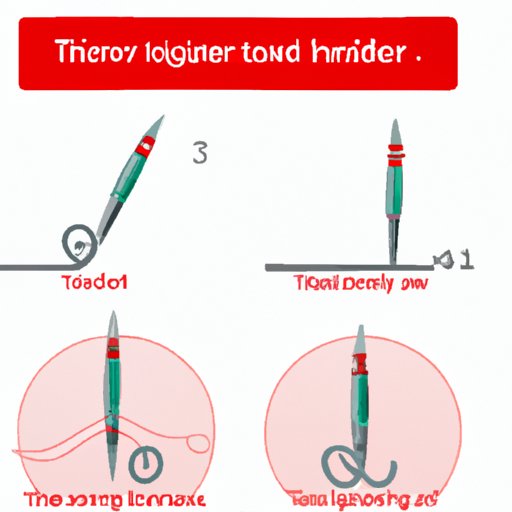
Introduction
Sewing is a fun and rewarding pastime, but it can also be frustrating, especially when it comes to threading needles. Fortunately, needle threaders can help make this task a breeze. In this guide, we’ll explore how to use a needle threader correctly, the different types available, common mistakes to avoid, and tips and tricks to make your sewing projects more manageable.
Step-by-Step Guide
Using a needle threader may seem intimidating, but with practice, it becomes second nature. Here’s a step-by-step guide on how to use a needle threader:
1. Choose a Needle Threader: Needle threaders come in many shapes and sizes, but they all function in the same way. Choose one that you’re comfortable using.
2. Insert the Wire: Insert the wire of the needle threader into the eye of the needle. Push it through until it comes out of the other side.
3. Thread the Wire: Place the thread over the wire and slide it down until the wire goes through the loop of the thread.
4. Pull the Wire: Pull the wire and thread back through the eye of the needle. Remove the wire, but leave the thread through the eye of the needle.
5. Done: Congratulations! You’ve successfully threaded your needle with a needle threader.
For visual learners, check out this video tutorial on how to use a needle threader: [insert video link]
Common Mistakes
Even with a step-by-step guide, mistakes can still happen when using a needle threader. Here are some common mistakes to avoid:
1. Choosing the Wrong Needle Threader: Not all needle threaders are created equal. Make sure to choose one that’s suitable for the size of your needle.
2. Improper Placement: If your needle threader is not placed correctly, the thread won’t pass through the eye of the needle. Ensure that the wire is fully inserted through the needle and that the thread is in the correct position.
3. Pulling Too Hard: While a needle threader can make threading needles easier, avoid pulling too hard on the thread. This could cause the threader to break or become misshapen.
Types of Needle Threaders
There are two main types of needle threaders: handheld and automatic. Handheld needle threaders are small devices with wires that help you thread a needle. Automatic needle threaders are built into sewing machines and can make the process even easier.
Here are some pros and cons of each type:
Handheld Needle Threaders
Pros:
- Affordable
- Portable
- Easy to use
Cons:
- Can only handle small needles
- Can become misshapen or break after prolonged use
Automatic Needle Threaders
Pros:
- Built into the sewing machine
- Can handle larger needles
- Usually more durable
Cons:
- More expensive
- May require professional maintenance
- Can be tricky to use for inexperienced sewers
Tips and Tricks
Using a needle threader is easy with a bit of practice, but these tips and tricks can help make the process even more efficient:
1. Always Use the Right Needle Threader: Using the wrong needle threader is a sure way to run into trouble. Make sure you have the right size and type for your needle.
2. Positioning is Key: Make sure your needle threader is in the correct position when threading your needle. If it’s at the wrong angle, it may prevent the thread from passing through the eye of the needle.
3. Tension is Important: Be sure to adjust the tension on your needle threader so that it works correctly with the type of thread you’re using.
Applications in Sewing Projects
Needle threaders are handy tools that can make a variety of sewing projects much more manageable. Here are some instances in which using a needle threader can come in handy:
1. Embroidery: Embroidery involves a lot of threading and rethreading of needles, making needle threaders essential. They make the process of changing out thread colors much quicker and more manageable.
2. Repair Work: Mending clothes can be tedious, but a needle threader can help make it more bearable. From reattaching lost buttons to fixing small rips, a needle threader makes the process much more manageable.
Conclusion
Needle threaders are tools that every sewer should have in their arsenal. They’re easy to use, make needle threading less frustrating, and are available in a variety of types. By following our step-by-step guide and avoiding common mistakes, you’ll be threading needles like a pro in no time.





